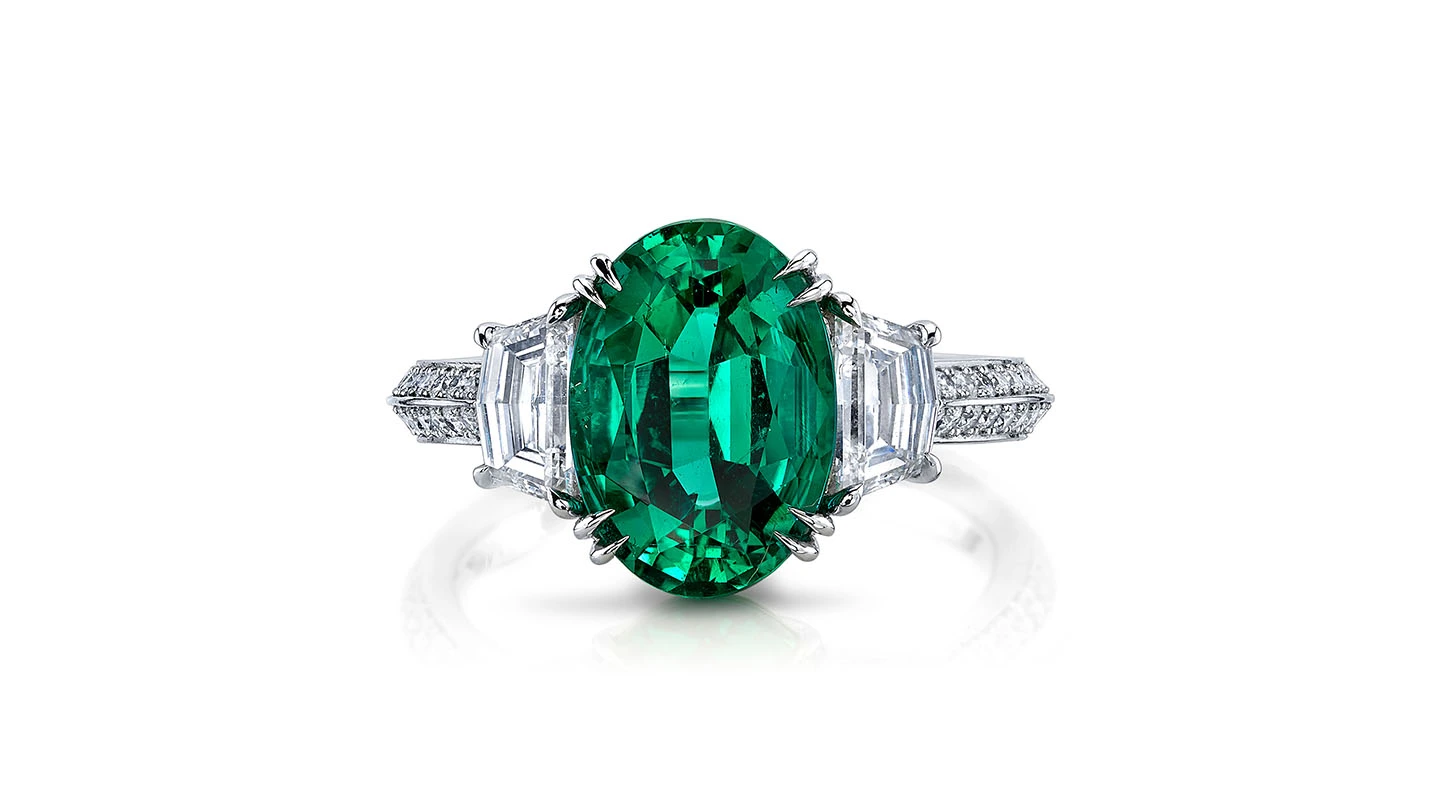Courtesy of Omi Privé.
Exuding classic grace and glamor, this platinum ring features a 3.38-carat emerald accented by 1 carat of epaulette cut side stones and numerous melee diamonds on its shank.
Captivating hearts for centuries with their elegance and beauty, emeralds and diamonds are two of the world’s most beloved gemstones. But when it comes to choosing between the two, how do you decide?
Before choosing between buying an emerald, a diamond or both, let’s explore what makes these gemstones exceptional. From their unique attributes, pricing considerations and fascinating symbolism, to their suitability for various personal styles and needs, each gem offers a unique beauty and rich history that can add a special touch to your jewelry collection.
What is a Diamond?
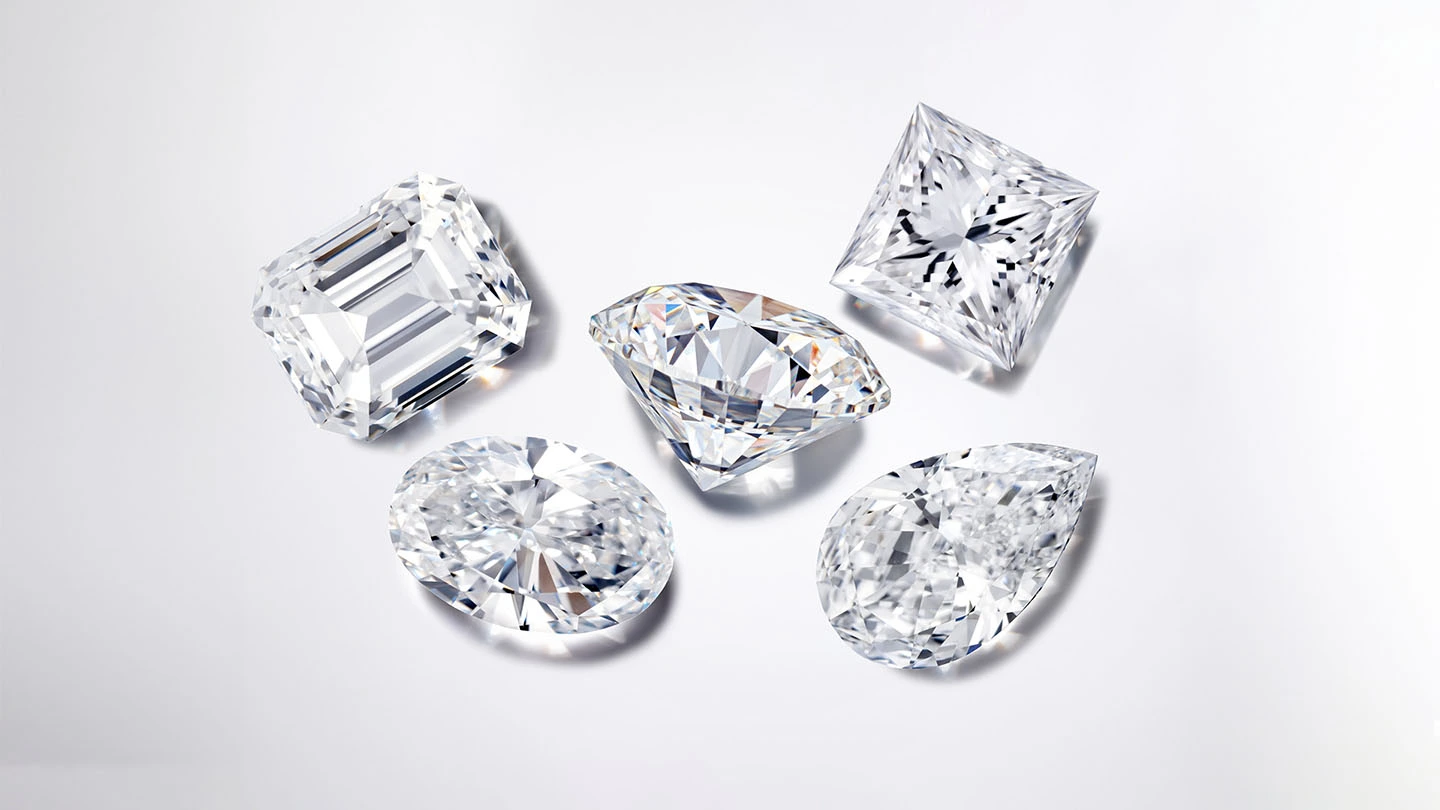
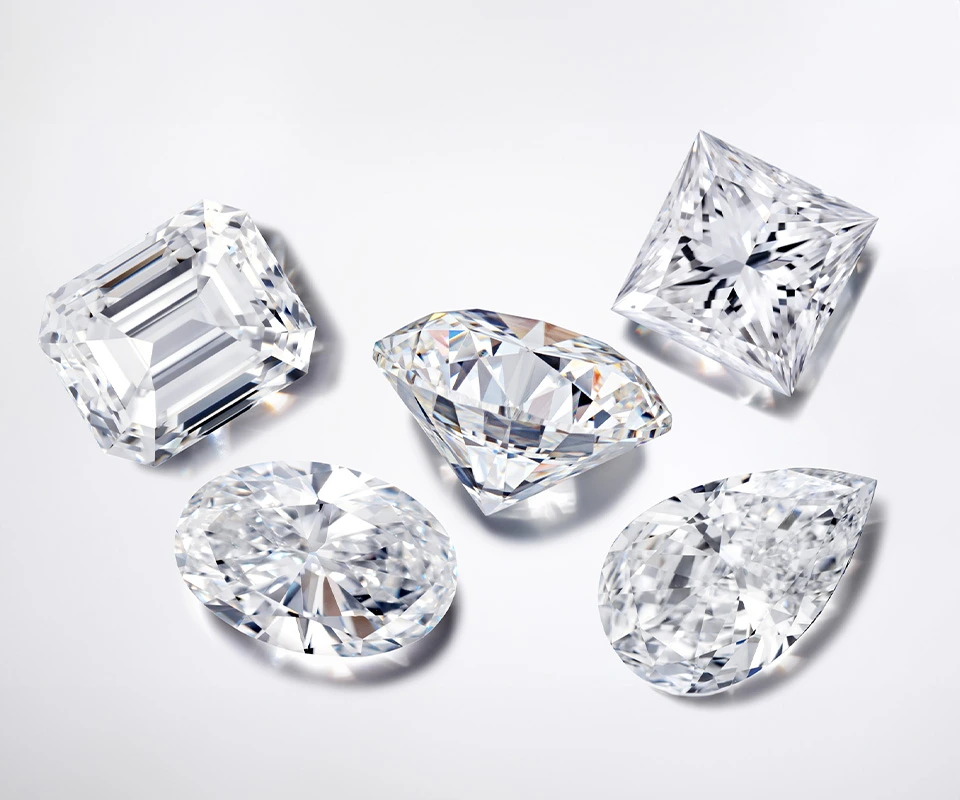
Diamonds are the hardest natural material on the planet, earning a perfect 10 on the Mohs scale of mineral hardness. This remarkable hardness makes them incredibly durable and a timeless choice for jewelry, from engagement rings to heirloom necklaces.
Natural diamonds are graded based on the 4Cs of Diamond Quality—cut, color, clarity and carat weight. Developed by GIA, this globally recognized, standardized grading system ensures every natural diamond is assessed objectively, giving buyers confidence in their purchase.
Every GIA diamond grading report provides a full assessment of the 4Cs and other vital information about your natural diamond. Although most people picture diamonds as colorless gems, rare fancy color diamonds exist with hues spanning the full rainbow of colors. As a classic emblem of enduring love and commitment, diamond jewelry often marks milestones such as engagements, weddings and anniversaries.
What is an Emerald?
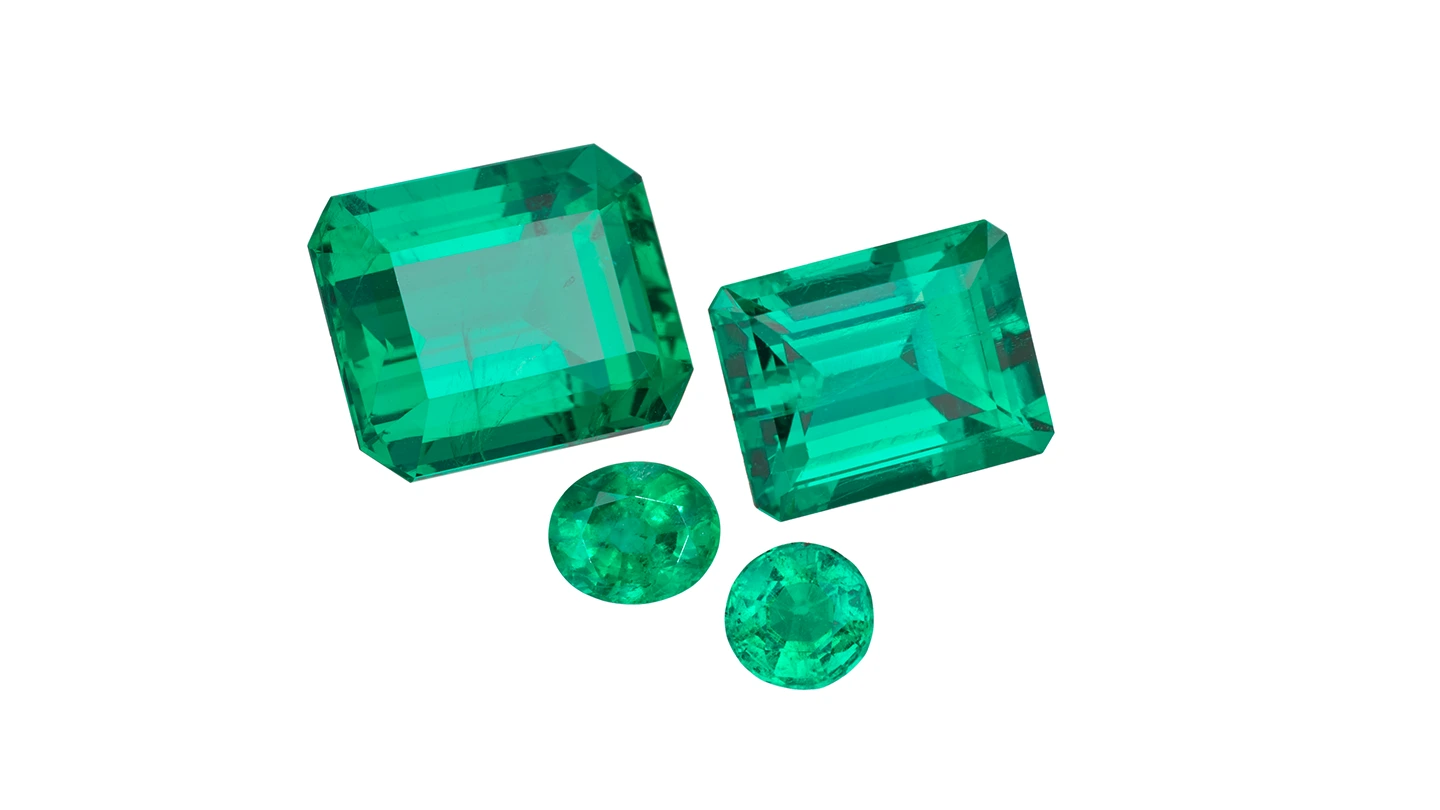
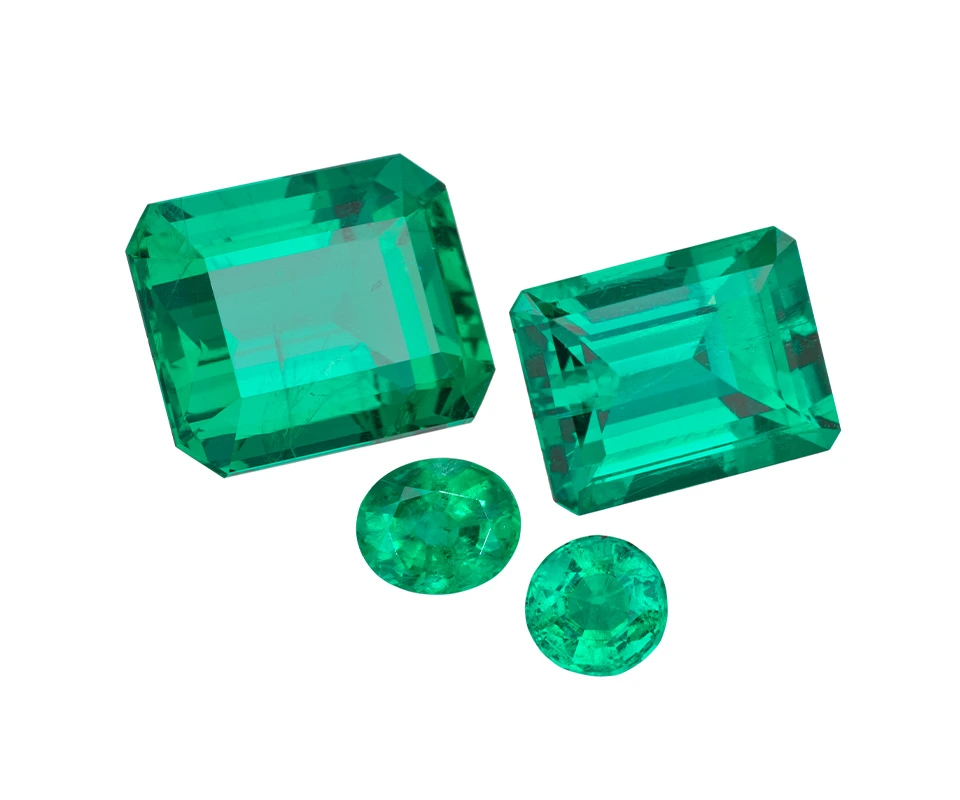
Emeralds are a variety of beryl, treasured for their enchanting green color and rich history. The name “emerald” comes from the Greek word smaragdus, meaning “green gem.” Throughout history, emeralds have symbolized rebirth and renewal and are often associated with spring and new beginnings.
Unlike diamonds, which are typically expected to be eye-clean, high-quality emeralds often have visible imperfections called inclusions. Inclusions are internal features or characteristics, such as tiny fractures or foreign materials trapped within the gemstone during its formation. Called jardin (French for “garden”), inclusions resembling plant foliage or moss can add charm and character to an emerald. With a hardness between 7.5 and 8 on the Mohs scale of mineral hardness, emeralds are durable but need more care than diamonds, partly due to their inclusions.
With their vibrant color and magnetic charm, emeralds are a great addition to any jewelry collection.
Diamonds vs. Emeralds: How Do They Form?
Origins of Diamonds
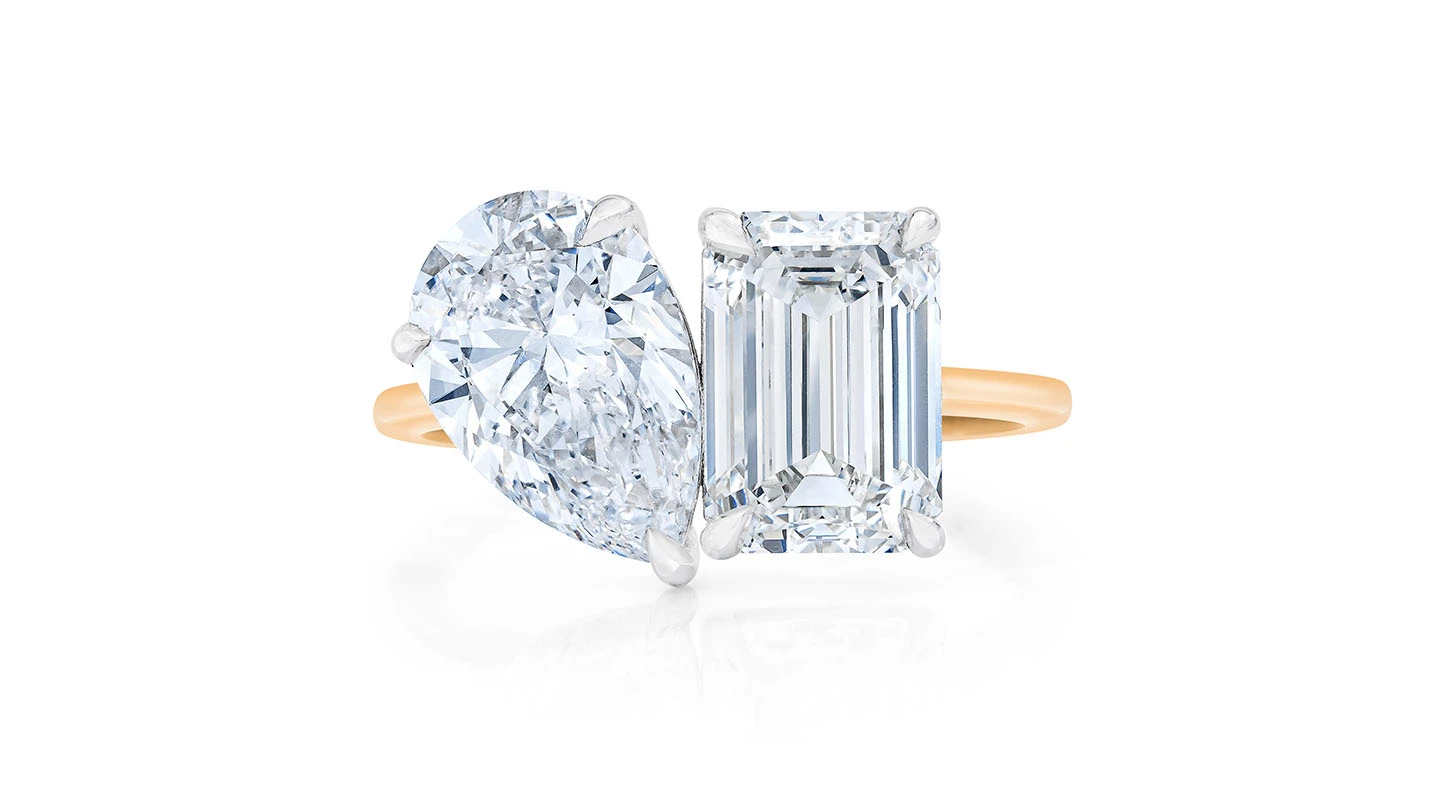
Symbolic and elegant, this toi et moi or “you and me” ring features a pear and an emerald cut diamond set side-by-side.
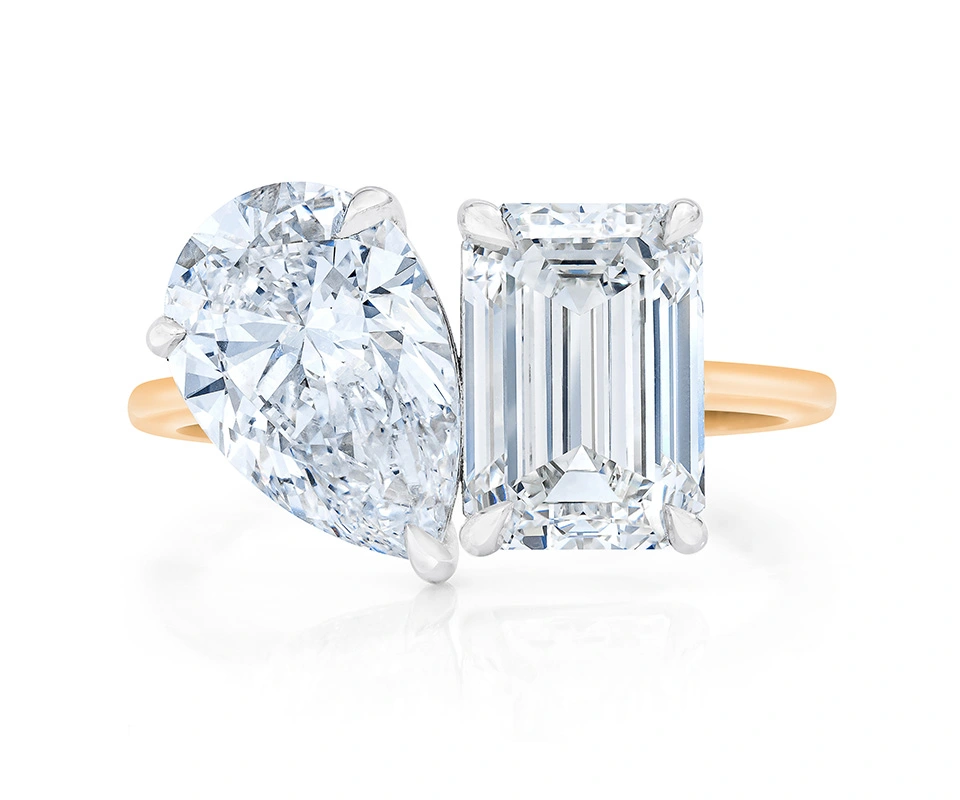
Symbolic and elegant, this toi et moi or “you and me” ring features a pear and an emerald cut diamond set side-by-side
Most natural diamonds formed around 150-200 km (about 95-125 miles) below the surface in Earth’s mantle, with some originating as far down as 800 km (about 500 miles). Millions to billions of years ago, high pressure and high temperatures crystallized carbon into durable gems. Ancient superdeep volcanic eruptions brought these diamonds closer to the surface, where they are mined in countries such as Botswana, South Africa, Canada and Australia.
Laboratory-grown diamonds—also known as man-made, lab-created or synthetic diamonds—are produced through processes that differ from natural diamond formation. While they share similar chemical, optical and physical properties with natural diamonds and may be hard to tell apart via the unaided eye after cutting and polishing, their crystal shapes and growth patterns reflect their distinct origins. Features such as inclusions and fluorescence patterns reveal their unique growth histories, making them readily identifiable to trained gemologists and expert laboratories like GIA.
GIA identifies the origin of each diamond submitted to our laboratories: natural diamonds are described by GIA Diamond Grading Reports, whereas laboratory-grown diamonds are issued GIA Laboratory-Grown Diamond Quality Assessments. Additionally, all laboratory-grown diamonds are inscribed with the term “Laboratory-Grown.”
Origins of Emeralds

Classic with a modern twist, these platinum earrings feature 13.60 carats of emeralds and roughly one carat of diamonds.

Classic with a modern twist, these platinum earrings feature 13.60 carats of emeralds and roughly one carat of diamonds
Are Emeralds More Expensive than Diamonds?
Natural emeralds form shallower in the Earth than diamonds, often within a few miles deep. Emeralds are a variety of the mineral beryl, which is composed of the elements beryllium, aluminum, silicon and oxygen. Ranging from vibrant bluish greens to luscious deep greens, their color comes from trace amounts of chromium and vanadium. Most emeralds are mined in Colombia, Zambia and Brazil.
To produce laboratory-grown emeralds, scientists use complex methods to recreate the natural conditions of their formation. These laboratory-grown stones have essentially the same physical and gemological properties as their natural counterparts.
Once sourced, expert artisans craft raw emeralds into gorgeous designs and shapes that highlight the stones’ exceptional qualities.
The price of diamonds and emeralds depends entirely upon their quality and carat weight—and in the case of emeralds, their potential treatments and country of origin. Exceptionally high-quality emeralds, especially those from renowned sources with little to no treatment, can sometimes command higher prices than high-quality colorless diamonds of the same size. However, fancy color diamonds, such as red, green, pink, purple and orange diamonds, are prized for their rarity, achieving the highest per-carat prices of any gemstone.
What Affects the Price of Diamonds and Emeralds?
Many factors influence the cost of a specific diamond or emerald. Let’s explore how prices are determined for these precious gems:
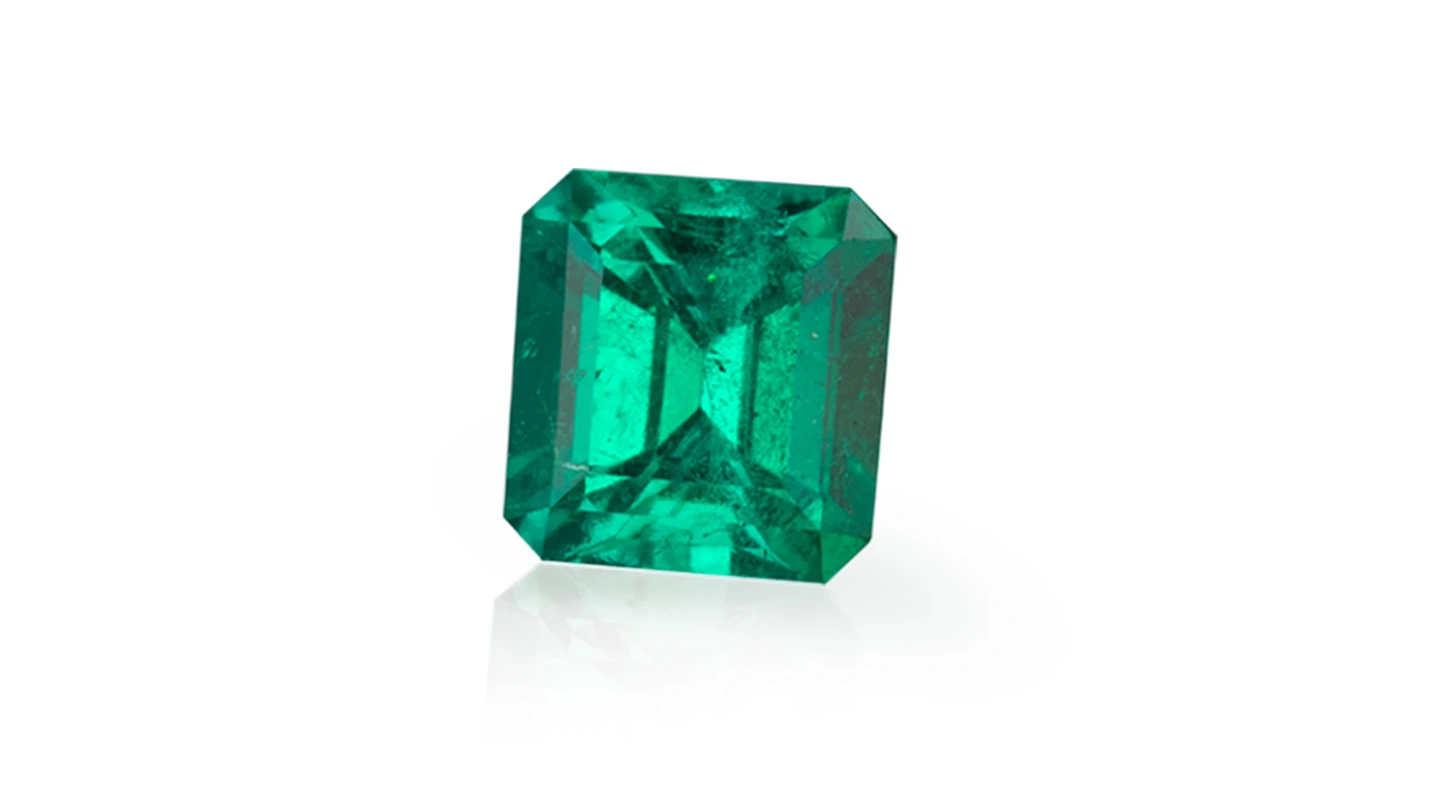
Emerald’s vibrant green color has influenced its association with wealth, wisdom, nature and rebirth throughout history.
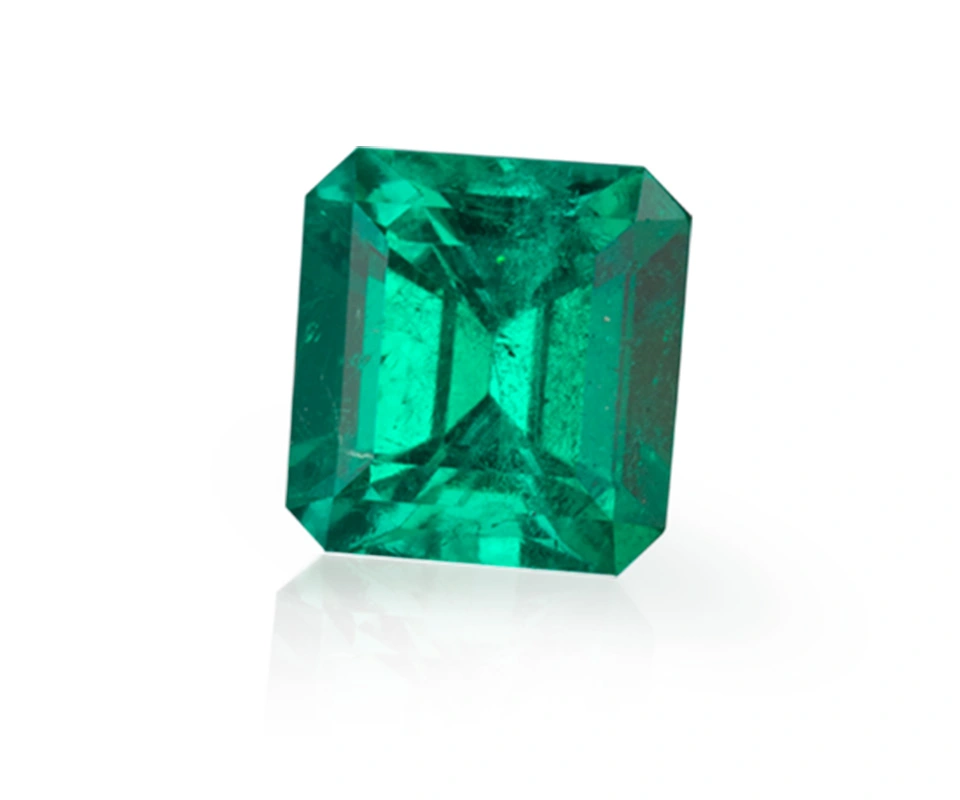
Emerald’s vibrant green color has influenced its association with wealth, wisdom, nature and rebirth throughout history
Gemstone Cut: Diamonds vs. Emeralds
Diamond Cut
The cut of a diamond determines how well the diamond interacts with light. A well-cut diamond dazzles with brilliance, fire and scintillation. Brilliance describes diamond’s internal and external reflection of light; fire considers the dispersion of light into the colors of the spectrum; and scintillation represents the patterns of light and dark areas that affect a diamond’s sparkle as it moves.
Certain cut styles cost more than others, with round brilliant diamonds typically costing more than fancy shape diamonds, such as ovals and pears. Round brilliant cut diamonds are also the only shape that currently receive a GIA cut grade, which ranges from Excellent to Poor.
The quality and craftsmanship of a diamond’s cut greatly affects its value. A poorly cut diamond can look dull and lifeless even with perfect color and clarity. Expert cutters balance proportions and symmetry to enhance the diamond’s natural beauty, ensuring that light enters and exits the diamond in the most visually appealing way.
Although fancy cut diamonds don’t receive GIA cut grades, you can still pick one with excellent craftsmanship.
Emerald Cut
The cut quality of an emerald influences brilliance, durability and vibrance. Inclusions in emeralds are typical and often accepted as part of their natural beauty. However, they can still impact the stone’s look and durability. Artisan gem cutters must consider these inclusions to ensure the stone looks great and stays strong.
Step cuts—like the classic emerald cut—are popular for emeralds because they maximize the crystal’s carat weight and are a gentler cut for gems with numerous inclusions. Oval cuts are also great options for emeralds. Their elongated shape can flatter fingers and make the gem appear larger.
Gemstone Color: Diamonds vs. Emeralds
Diamond Color
Diamond color is graded on a scale from D to Z, with D representing completely colorless diamonds and Z indicating diamonds with noticeable yellow or brown color. Within this range, the closer a diamond is to being colorless, the rarer the diamond and the higher its value.
Beyond the traditional D-to-Z scale, diamonds can also come in every color of the rainbow, though most fancy color diamonds are yellow or brown. Diamonds with rare colors, like red, purple, pink, green, orange and blue, are scarce, often fetching millions of dollars per carat at auctions.
A diamond’s color can be modified by treatments, such as high-pressure high-temperature (HPHT) annealing or artificial irradiation. Treated diamonds are more affordable than untreated natural diamonds of similar quality. GIA tests every diamond for color treatments and includes any information about treatments in every report, so you know exactly what you are buying.
Emerald Color
For emeralds, color is the most critical factor in determining cost, with the most valuable emeralds displaying a vivid green to bluish green. Color is so important that only beryl with saturated enough green color gets to be called emerald. Anything lighter is called green beryl. Saturation is the most important factor; as the intensity of green color goes up, so does value. An emerald’s color should be evenly distributed, with no visible color zoning.
Gemstone Clarity: Diamonds vs. Emeralds
Diamond Clarity
A diamond’s clarity is determined by the number of inclusions within the gemstone and blemishes on its surface. These imperfections can impact a diamond’s clarity by obstructing light and diminishing brilliance, depending on their visibility and position within the stone.
Diamond clarity is graded on a scale from Flawless (FL) to Included (I), with various grades in between, and is defined by the visibility of its clarity features when the diamond is viewed under 10x magnification. Flawless diamonds with no visible internal or external imperfections are prized for their rarity. On the other end of the spectrum, Included diamonds have noticeable inclusions and blemishes that can negatively affect their brilliance and durability.
Several techniques have been developed to enhance diamond clarity and remove imperfections, including laser drilling and fracture filling. While these clarity treatments can improve a diamond’s appearance, they usually reduce the stone’s overall value compared to untreated diamonds of similar clarity. GIA only issues reports for permanent, stable clarity treatments like laser drilling and notes evidence of this treatment on its reports. GIA does not grade diamonds that have been fracture-filled, since the filling material can be damaged or removed.
Emerald Clarity
The clarity standards for emeralds differ from those for diamonds. Inclusions in emeralds are not only expected but sometimes poetically called jardin, or “garden” in French. Particularly interesting or unusual inclusions, like those that form a star or cat’s eye in emerald, can even boost a gem’s appeal to collectors.
However, not all imperfections are desirable. While inclusions add character, they can also affect an emerald’s durability and transparency. Generally, stones with fewer noticeable inclusions cost more. Eye-clean emeralds, which have no visible inclusions to the naked eye, are extremely rare and highly valued.
Clarity treatments are typical for emeralds. Filling fissures with oil, wax or resin is the most common emerald clarity treatment. Untreated emeralds of high quality, however, are more valuable. A GIA Colored Stone Identification Report always includes information about existing treatments, including degree of treatment—minor, moderate or significant—and type of filler, including:
- A: oil, wax or natural resin
- B: artificial resin
- C: the clarity enhancing material present cannot currently be identified.
If you buy a treated emerald, be sure to ask your jeweler about how to care for your emerald, since treatments impact how to clean and care for your gem.
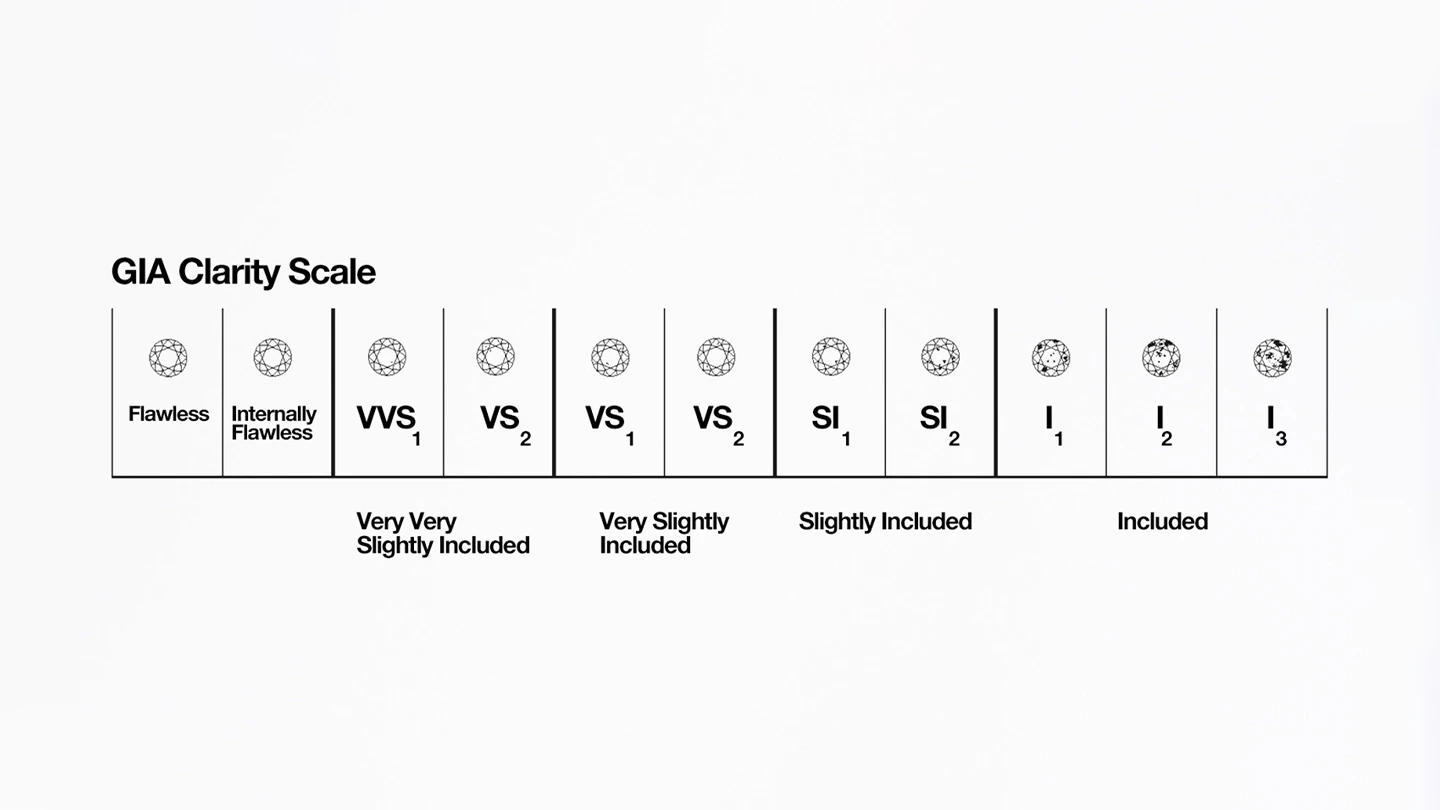
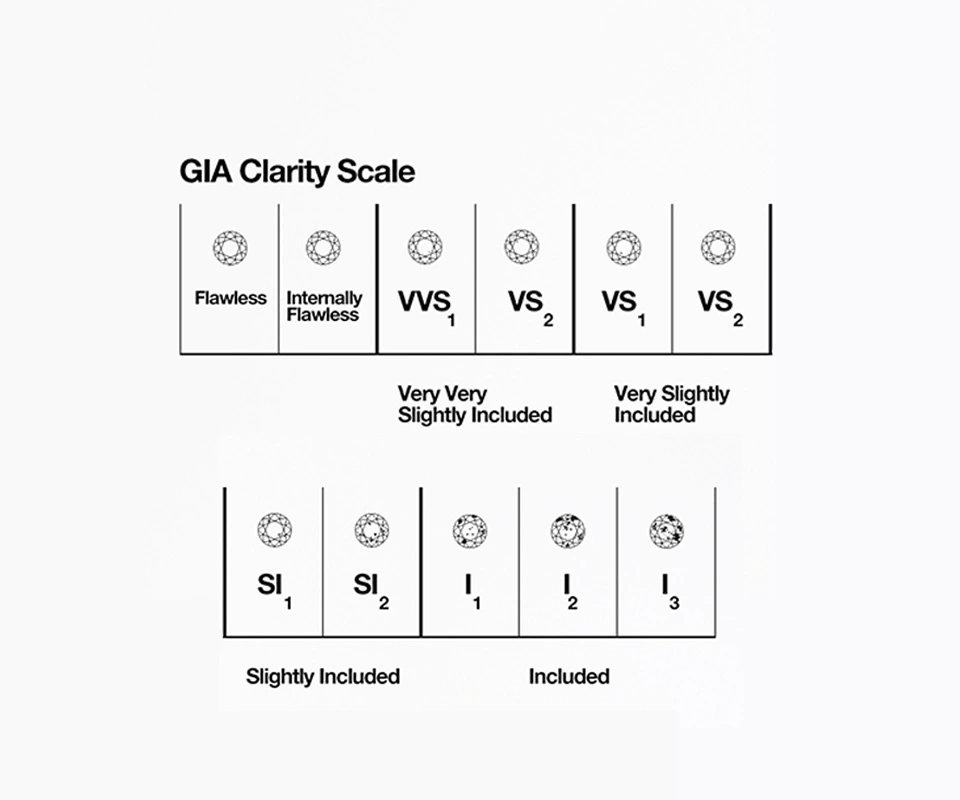
Gemstone Size: Diamonds vs. Emeralds
Diamond Size
Carat weight dramatically affects a diamond’s price. A carat is a unit of weight equal to 200 milligrams, and every diamond is meticulously measured to the nearest hundredth of a carat to ensure accurate pricing. As carat weight increases, typically so does the price. However, the cost increase can be exponential due to the rarity of larger diamonds. For instance, a 2-carat diamond will cost significantly more than twice that of a 1-carat diamond.
A well-cut diamond can appear larger and more brilliant than a poorly cut one with the same or higher carat weight. Therefore, while carat weight is important, a smaller diamond of higher quality can sometimes cost more than a larger stone.
Emerald Size
As with diamonds, larger emeralds are rarer and more valuable, especially those with few inclusions and rich green coloring. Since emeralds have lower density than diamonds, they are larger than diamonds of equivalent carat weight, spanning larger volumes.
Should I Buy an Engagement Ring with Diamonds or Emeralds?
Choosing the perfect engagement ring for a proposal is an exciting journey. Whether you’re considering diamonds, emeralds or both, answer a few important questions to ensure your ring reflects your and your partner’s love story:
What is the wearer’s style?
Most people love showing off their engagement ring, so choose a look that matches your partner’s unique personality and preferences.
Diamonds are a classic choice for engagement rings due to their timeless elegance, incredible hardness and unmatched brilliance. With the right design, a diamond ring can suit any style, from classical to modern and intricate to bold. If you want a versatile ring that pairs well with everything, a diamond is the way to go.
Emeralds are perfect for anyone who wants to make a statement. Their rich green color is eye-catching and unique. Imagine a step cut emerald flanked by baguette diamonds—a piece that says you’re bold and love a touch of vintage glamor. Emeralds are also trending in modern settings, like bezel or east-west settings, giving them a contemporary twist.
Do I need a gemstone that holds up to an active lifestyle?
Some gemstones handle daily wear and tear better than others. Diamonds excel in durability. With a perfect 10 on the Mohs hardness scale, they can easily withstand scratches. Chemically resistant, you can maintain their sparkle using a wide range of jewelry cleaners. It is also safe to put most diamonds in ultrasonic cleaners.
For at-home care, we recommend cleaning your diamond jewelry regularly with dish soap and a soft bristled toothbrush as a gentle way to remove oils and dirt. Though hard, diamonds are brittle and could chip if they experience a sharp blow. Settings can be designed to protect vulnerable edges and points.
Emeralds are more delicate than diamonds. They score between 7.5 and 8 on the Mohs scale, making them relatively hard gemstones, but their natural inclusions can weaken them. Many are oiled or fracture-filled to increase their clarity and durability. Because of this, they should never be put in ultrasonic cleaners, which can damage their filling. However, with extra care and the right protective ring setting, you can keep emerald engagement rings looking incredible for a lifetime and beyond.
Can I get a diamond or emerald engagement ring within my budget?
Most likely! There are numerous ways to save money on a diamond. These include being familiar with which of the 4Cs to prioritize and choosing a ring setting that makes your diamond look bigger.
The same goes for emeralds. Halos, pavé bands, side stones and other setting styles can make your center stone appear larger and your ring look more glamorous.
What is the symbolism of diamonds and emeralds?
Engagement rings often incorporate important symbols within the design—and nothing says “forever” quite like a diamond due to their extreme age and hardness. The unrivaled transparency of a diamond represents the purity of your love and intentions as you build a life together.
Emeralds symbolize rebirth, prosperity, renewal and growth, making them perfect for a couple starting a new chapter. Choosing an emerald signifies a fresh start and a flourishing journey, adding more meaning to your engagement ring.
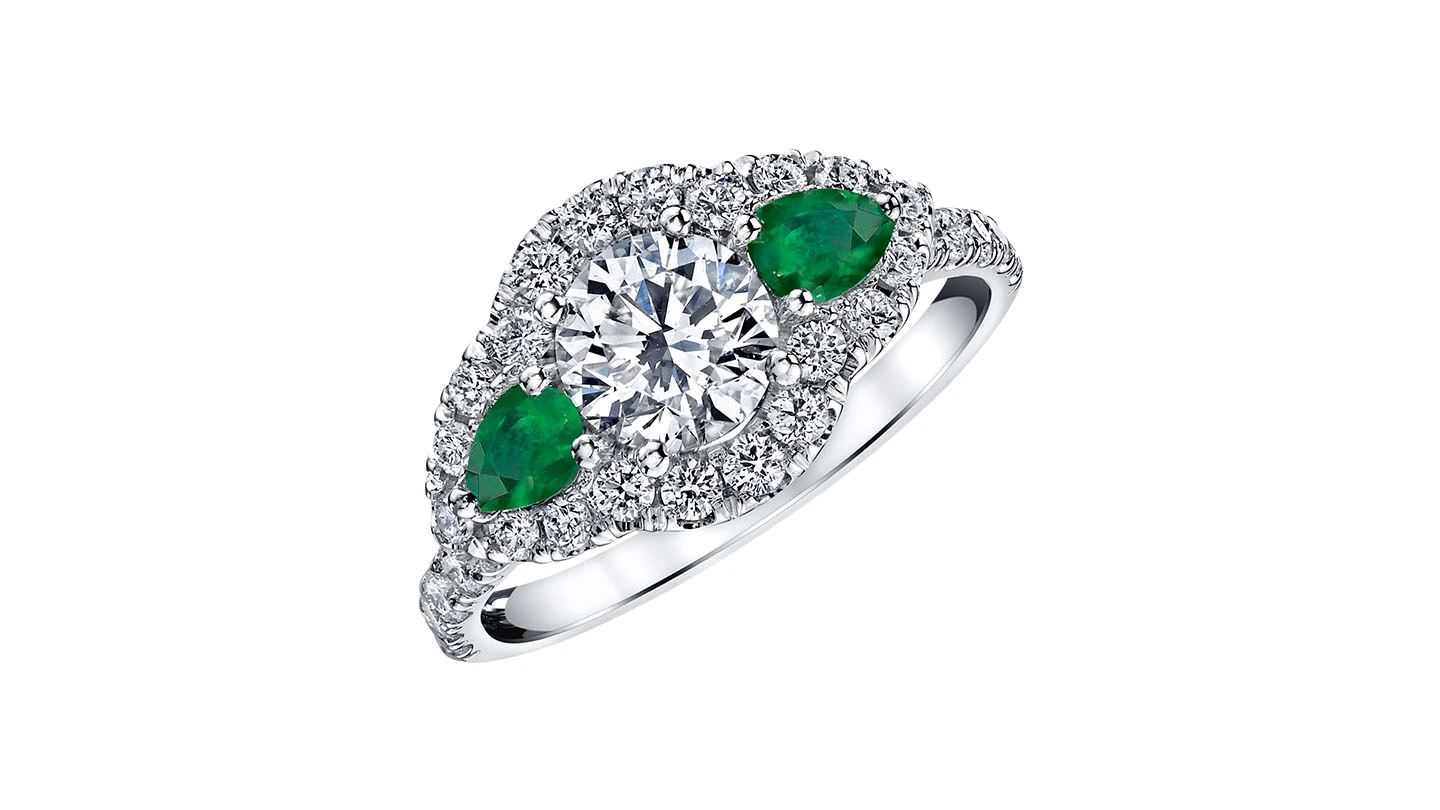
Modern with a fun pop of color, this three-stone engagement ring consists of a round brilliant diamond center stone flanked by pear-shaped emerald side stones and surrounded by a halo of diamonds.
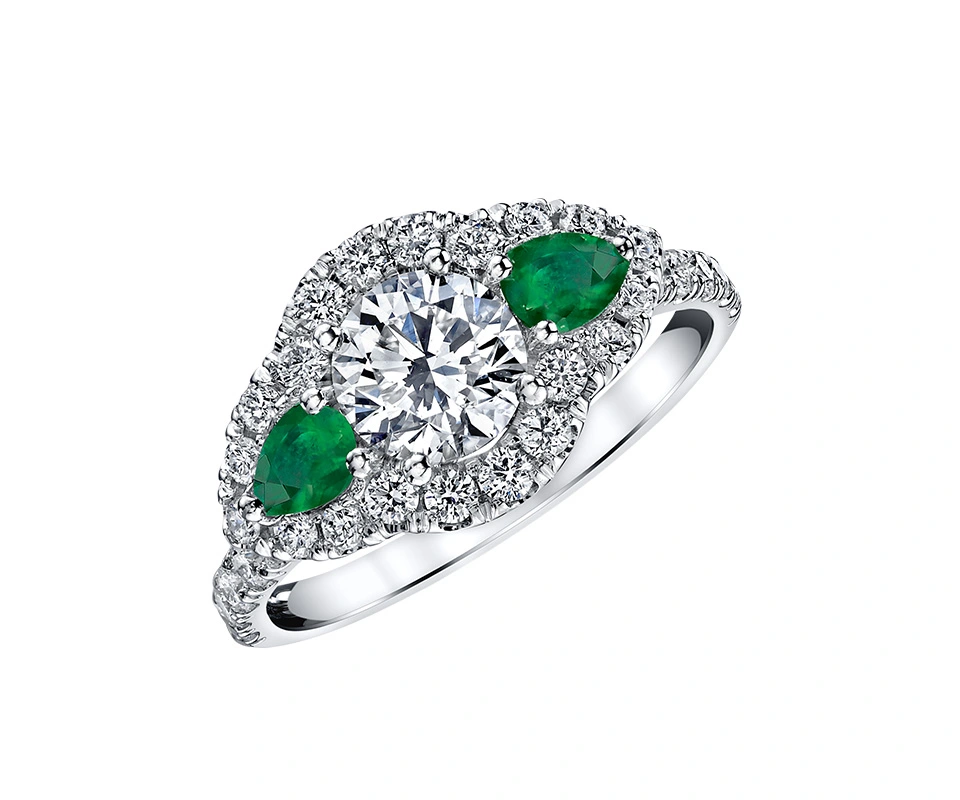
Modern with a fun pop of color, this three-stone engagement ring consists of a round brilliant diamond center stone flanked by pear-shaped emerald side stones and surrounded by a halo of diamonds.
Tips for Buying Diamonds and Emeralds in Your Budget
Finding the ideal gemstone for your engagement ring while staying within your budget might seem daunting. However, these savvy strategies can help you discover a stunning ring without overspending.
1. Set a Reasonable Budget
First, establish a realistic budget for your engagement ring. By setting clear limits from the start, you can focus on finding the perfect ring without adding financial stress.
When creating your budget, remember to account for the cost of the ring setting, accent stones and custom designs, as these additional expenses can add up.
Dig into Engagement Ring Pricing and How to Create a Budget
2. Learn the 4Cs of Diamond Quality
Understanding the 4Cs—cut, color, clarity and carat weight—is vital for selecting a beautiful diamond within your budget. Balance each stone’s characteristics with your budget and preferences to find a stunning diamond that meets your unique needs.
For instance, choose a near-colorless diamond with an Excellent cut grade at a lower carat weight if you prioritize brilliance. This ensures a dazzling diamond that appears spectacular at a reasonable budget. Alternatively, consider a large central emerald with an eternity band of small diamonds. This combination makes the ring more affordable and adds an eclectic and dramatic flair.
While the 4Cs don’t technically apply to emeralds, you can use a similar approach to find the right gem by working with an expert jeweler.
Learn More About the 4Cs of Diamond Quality
3. Consider Color and Cost of Emeralds
For emeralds, color and price are linked—the more intense the green, the rarer and more expensive the emerald. However, emeralds with slightly lighter green hues can be just as captivating and budget friendly. Yellowish-green emeralds are sometimes more affordable than pure green or bluish green emeralds of the same saturation.
Discover More About Choosing the Perfect Emerald
4. Don’t Overlook Gemstone Settings and Accents
Straightforward settings, like a classic solitaire in prong or bezel designs, usually cost less than elaborate settings with multiple diamonds. Using emeralds or other colored gemstones as accents instead of additional diamonds can be stylish and affordable. Complementary halo settings can sometimes make the center stone look larger, as well as add sparkle.
Choose Emeralds and Diamonds Professionally Analyzed by GIA
Choosing between the brilliant sparkle of diamonds and the captivating green of emeralds can be an exciting yet intimidating challenge. Always consult with a GIA-trained retailer near you to ensure you make the best choice for you.
Be sure to ask for a GIA report for your diamond or emerald. A GIA report verifies key information about your gemstone, including any color or clarity treatments. For natural diamonds, reports include a full assessment of the stone’s 4Cs of quality. GIA reports promote transparency and provide confidence in your purchase.
